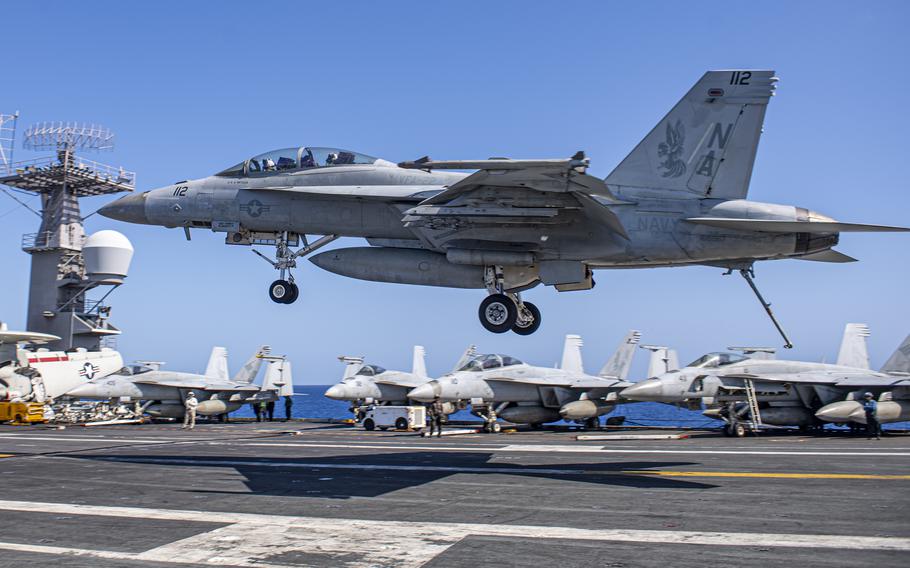
An F/A-18F Super Hornet lands on the flight deck of the aircraft carrier USS Nimitz in the Phillippine Sea, May 12, 2023. In a report released May 16, the Navy pointed to bilge water as the source of jet fuel contamination aboard the ship last fall. (Justin McTaggart/U.S. Navy)
A cascade of errors and lapses in judgment along with poor communication resulted in contaminated drinking water aboard two aircraft carriers last fall that sickened at least 11 sailors on one of the ships, Navy investigators have found.
In separate reports released Monday, the Navy pointed the finger at bilge water as the source of jet fuel contamination on USS Nimitz and bacteria found aboard USS Abraham Lincoln on Sept. 16 and Sept. 21 of last year, respectively.
Bilge water may contain chemicals, oil, sewage leaks, seawater, sludge and other runoff that collects in the lower areas of a ship.
In the case of Nimitz, liquid contaminated with JP-5 fuel leaked into a potable water tank through a failed gasket, according to a report dated Oct. 26, 2022.
The ship moored at Naval Air Station North Island in San Diego for just over two weeks, while its potable water system was flushed with a million gallons of clean water.
At least 11 sailors reported skin rashes, headaches and diarrhea, symptoms that may have resulted from ingesting jet fuel.
All 11 sailors were cleared for duty by Oct. 5, the Navy said in a statement Monday.
Aboard Lincoln, corrosion caused a hole in a potable tank’s vent piping, which allowed bilge water to seep in, investigators said in a report dated Nov. 10, 2022.
E. coli was found in three of the ship’s potable water tanks, but no related illnesses were confirmed, Stars and Stripes reported in October.
The detailed reports released by the Navy months after their completion also show that personnel aboard both ships failed to effectively communicate concerns, ignored warning signs and didn’t follow procedures to ensure drinking water was safe.
For example, contamination of Nimitz’s water system came after crew members used a potable water pump to flush a tank that hadn’t been in service since at least 2020.
Investigators said the ship’s plan, which included emptying as many as six other tanks, didn’t ensure the pipes were properly flushed, effective and clean, according to the report.
But investigators pointed out that while Navy manuals showed how to address bacterial contamination, foul taste and murky water, they didn’t say what to do about correcting jet fuel or chemical contamination.
The Nimitz report also revealed that a previous crew didn’t formally document that the tank in question was contaminated with seawater and, as it turned out, jet fuel, sometime between June 2020 and March 2021.
Although an informal tracking sheet indicated the tank was out of service due to seawater infiltration, the follow-on crew “did not know or consider the possibility that the tank might contain contaminants other than seawater,” investigators said.
Aboard Lincoln, investigators found that the tank’s vent piping wasn’t being monitored closely enough. That report also found four missed opportunities by sailors to identify and address drinking water contamination before it spread throughout the ship.
For example, on Sept. 17, crew members noticed an unexplained change in a water tank level but took no action.
Five potable water tanks on the ship tested positive for bacteria in early 2022, “a deviation that was allowed to normalize,” the report states.
“As no other (aircraft carrier) has had a potable water tank test positive for bacteria in the past two years, this should have been a warning sign,” the report stated.
Both reports included recommendations for each ship.
Nimitz received 13 of them, including one that ship leaders work with Navy officials to assess and update how they manage their drinking water supply.
The Lincoln report listed 18 recommendations, including completion of a critique to fully understand the scope of the inactions led to the contamination.